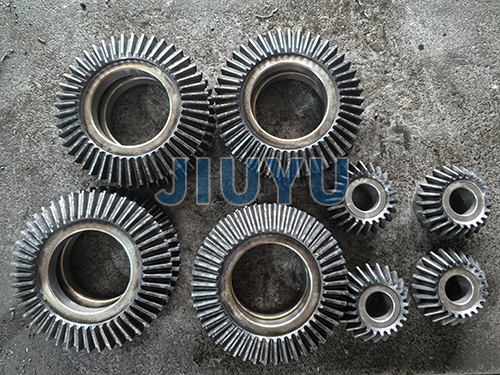
Umbrella gear,also known as bevel gear,is a type of gear used for transmission between intersecting shafts.The following is a detailed introduction to it:
Structural characteristics
The teeth of a bevel gear are distributed on the surface of a cone,and its shape is conical,hence it is called a bevel gear.
Its tooth shape gradually decreases from the big end to the small end,and the modulus and pressure angle also change accordingly.For the convenience of design,manufacturing,and measurement,large end parameters are usually used as standard values.
Working principle
When a pair of bevel gears mesh with each other,their motion transmission is similar to the pure rolling of two cones.The teeth of the driving bevel gear push the teeth of the driven bevel gear,causing the driven bevel gear to rotate around its axis,thereby achieving power transmission and motion conversion between intersecting axes.
The angle of intersection between the two axes can be any angle,but the commonly used one is 90°.
type
Classified by tooth profile shape
Straight bevel gear:The tooth profile is a straight line and intersects with the gear axis.Straight bevel gears are easy to manufacture and have low costs,but they have poor stability and high noise during transmission,making them suitable for low-speed,light load transmission scenarios.
Diagonal bevel gear:The tooth line is spiral,which has good transmission stability and high load-bearing capacity,but requires high manufacturing and installation accuracy.It is commonly used in high-speed and heavy-duty transmission systems.
Curved bevel gear:The tooth profile is curved,such as a circular arc bevel gear.It combines the advantages of straight and helical bevel gears,with smooth transmission and high load-bearing capacity.It is widely used in various machinery that requires effective and smooth transmission,but the processing technology is relatively complex.
Classified by cone shape
Orthogonal bevel gear:A type of bevel gear with two axes intersecting at a 90°angle,which is a common type and widely used in various mechanical transmissions.
Diagonal bevel gear:A bevel gear with two axes intersecting at an angle of not 90°,which can be designed with different angles according to specific transmission requirements and is suitable for some special transmission situations.
application
Umbrella gears are widely used in the mechanical industry and are commonly used in car differentials.They enable the left and right wheels of a car to rotate at different speeds when turning,protecting the vehicle from running smoothly.
In the transmission system of machine tools,bevel gears can be used to achieve motion transmission between different coaxial lines,change the direction and speed of motion,to meet the requirements of various machining processes of machine tools.
In addition,in mechanical equipment in industries such as aerospace,shipbuilding,metallurgy,and mining,bevel gears also play an important role in transmitting power and achieving motion conversion.
design and manufacturing
Design:When designing umbrella gears,it is necessary to determine parameters such as gear module,number of teeth,pressure angle,helix angle,etc.based on transmission requirements.At the same time,it is necessary to consider factors such as the strength,performance,and transmission efficiency of the gears to confirm that they can effectively transmit power during operation.
Manufacturing:Manufacturing umbrella gears requires high precision and complex processes.Generally,gear blanks are first manufactured through forging or casting methods,and then subjected to cutting processing,including gear profile machining,heat treatment,and other processes.Gear profile machining usually uses specialized gear machining machines,such as hobbing machines,hobbing machines,etc.,to protect the accuracy and surface quality of the gear profile.Heat treatment can improve the hardness,strength,and performance of gears,extending their service life.



